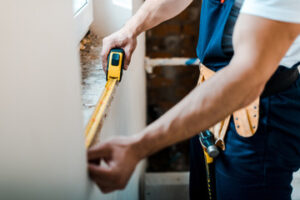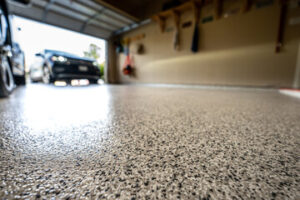Handymen are jacks of all trades, performing general repair and maintenance work that electricians, plumbers, and similar professionals cannot.

They can take care of your honey-do list and make sure your home is looking its best. Contact Handyman Chandler for professional help.
A utility knife is essential to any handyman’s toolkit, allowing for precision cuts on many materials.
Typically, handymen can offer general plumbing repair services, including faucet replacement, drain cleaning, and toilet repairs. However, they may not be qualified to handle more complex projects that require a licensed plumber. For example, a licensed plumber would be needed to replace a water heater or install a new shower. Moreover, a plumber is required to follow strict health and safety standards when working on a plumbing project. Therefore, it is important for homeowners to find a reputable plumber who can complete all of their plumbing tasks safely and efficiently.
In addition to being able to perform basic maintenance tasks, a handyman should be skilled at a variety of other trades. Some handymen are skilled in carpentry, electrical work, and painting. Others have a more specialized skill set, such as drywall installation or plumbing repairs. Handymen can also help with home improvement projects that require a licensed professional, such as installing an alarm system or rewiring a home.
A handyman salary can vary greatly depending on their education, experience, and licensing. In most cases, handymen receive on-the-job training and apprentice with other experienced professionals. They can also improve their skills by attending vocational schools or completing internships. This is an excellent way to gain valuable job experience and become more proficient in their craft.
As a handyman, you must be able to understand blueprints and mechanical diagrams in order to complete various repair and maintenance tasks. You must also be comfortable working with power tools and machinery. Ideally, you should have a high school diploma or equivalent. Additionally, a valid driver’s license is important to ensure that you are safe on the job.
While there are many similarities between a handyman and a contractor, there are some key differences. A handyman does not need a license to provide certain services, but a contractor is required to have a special license to perform these types of projects. Additionally, a contractor generally manages multiple projects at once and oversees a team of individuals.
Handymen are highly skilled in a wide range of maintenance tasks and repairs, making them a great choice for small jobs that don’t require the expertise of a specialized contractor. They are also a good option for homeowners looking to save money by tackling some projects themselves.
Electrical
Electrical work is one of the most important jobs a handyman can take on because it can cause significant damage and injuries if done incorrectly. Handymen with experience in this type of work are able to run wires, install outlets and switches, fix lighting fixtures and even do minor rewiring to make sure all wiring is safe and up to code. They can also handle other electrical tasks like setting up electric devices, such as coffee makers and televisions.
Another electrical service that handymen can perform is installing ceiling fans. These are a great way to add some extra light and airflow to a room while also adding to the aesthetic of the space. Handymen are often able to complete this work quickly and efficiently, saving their clients time and money.
The handyman may also be able to install additional lights in areas where there was no previous lighting. This process involves running new wires, making sure there is enough power for the fixture and then attaching it properly. This is something that many people don’t realize needs to be done, but it’s an important part of any home improvement project.
A handyman may also be able to install or replace smoke detectors in their client’s homes. This is a great way to protect the safety of everyone in the house, especially children and elderly individuals. It’s also a great way to ensure that the family is prepared for any emergencies that may occur, such as fires or natural disasters.
If the handyman is working on a bigger, more complex electrical project, they should always check with their boss or supervisor to make sure that they are licensed to do so. This will help to avoid any potential issues in the future, such as when a home inspector comes to look at the work and finds that it was done incorrectly and could be dangerous for residents.
Having a handyman who is licensed to do this type of work will save the homeowner money in the long run, as they will be able to avoid any costly mistakes. This can also help to increase the value of a property, since buyers will know that the work is high-quality and has been done correctly.
Painting
Handymen often have the skills and equipment to paint walls and ceilings inside or outside your home, transforming living spaces with fresh coats of color that revive a room’s appearance. They’re also adept at patching and smoothing drywall to prepare surfaces for painting, ensuring a polished look that will last.
In addition to the broader categories of repairs and improvements, Handyman can also tackle more complex jobs. These might include tearing out and replacing a shower floor, fixing the joists and subfloor, redoing the plumbing and re-tiling, moving or replacing an electric line, building new custom cabinets for the entire kitchen, adding a second story to a ranch-style house, or turning a den and living room into a master suite. Handymen will usually refer you to a licensed professional for these kinds of significant projects.
One of the most popular services Handy provides is interior and exterior painting, as well as staining decks or refinishing floors. They can refresh a bathroom with new caulking, grout, or soap dishes, or give a kitchen a facelift with new cabinets, countertops and backsplashes. They can also hang artwork, shelving and other wall hangings for you.
Painters are experts in their field, and Handy has painters that can transform your space with quality work at an affordable price. When you use Handy’s service, you get clear, transparent quotes for your project that can be paid online. If you’re not 100% satisfied with your service, Handy has a Happiness Guarantee to make it right.
Handymen can also repair scuffed or peeling paint on trim and walls, making them look like new. They can also lay and install crown molding to add a premium motif to your space, or simply replace old trim to make rooms feel clean and updated.
Patching dents, scrapes and holes in drywall is one of the most common handyman requests, as it can greatly improve the look of any room or wall. Handymen can also apply high-durability coatings to walls, which can protect them from stains and wear. They can even help you choose the best paint colors for your space and provide a wide variety of color options.
Flooring
Whether you’re looking to spruce up your home’s aesthetic or boost its resale value, updating your flooring is a great way to do both. Handyman professionals can install a variety of flooring types, including vinyl, hardwood, and luxury vinyl plank (LVP). In addition to installing new floors, handymen can also remove existing ones and repair damage.
Handymen are capable of performing a wide range of tasks, ranging from basic plumbing repairs to bathroom renovations. However, before you hire a handyman, be sure to research their credentials and ask for references. It is also important to check if they are insured and bonded. This will ensure that you are protected in case of any damages or accidents during the project.
Often, a handyman is required to perform general maintenance and repair tasks in both residential and commercial settings. In many cases, they may work independently or as part of a team of contractors. In either scenario, they are responsible for ensuring that the construction project is completed on time and within budget.
As a result, handymen must have a wide range of skills to effectively address these tasks. They must be able to use various tools, repair and install different fixtures, and follow all safety regulations. Depending on the nature of the work, they may also be required to travel between different locations to complete their assignments.
One of the most common tasks performed by handymen is repairing and painting walls. This service is usually needed when surfaces are damaged or worn out, such as scratches and dents from furniture or roughhousing children. Handymen can also apply wallpaper to give rooms a fresh look.
Tile installation is another service offered by handymen. This is a complex job that requires experience and skill. Handymen can install new tiles on both floors and walls. They can also refresh grout to make tiled areas appear pristine and new.
Before hiring a handyman, it is important to assess your needs and make a list of all the tasks you would like them to complete. Once you have made a list, search online for qualified professionals in your area. After selecting a handyman, be sure to discuss the terms of the project and review their cancellation and refund policies.


